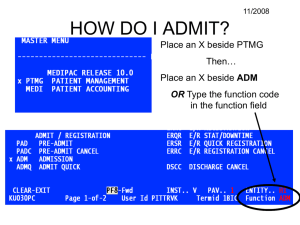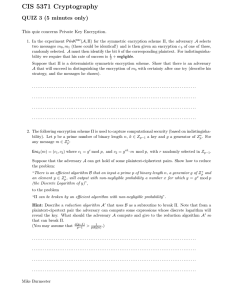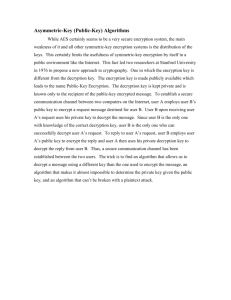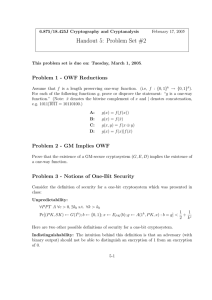Lecture 13: NIZK and the Lunchtime Attack 1 Overview
advertisement
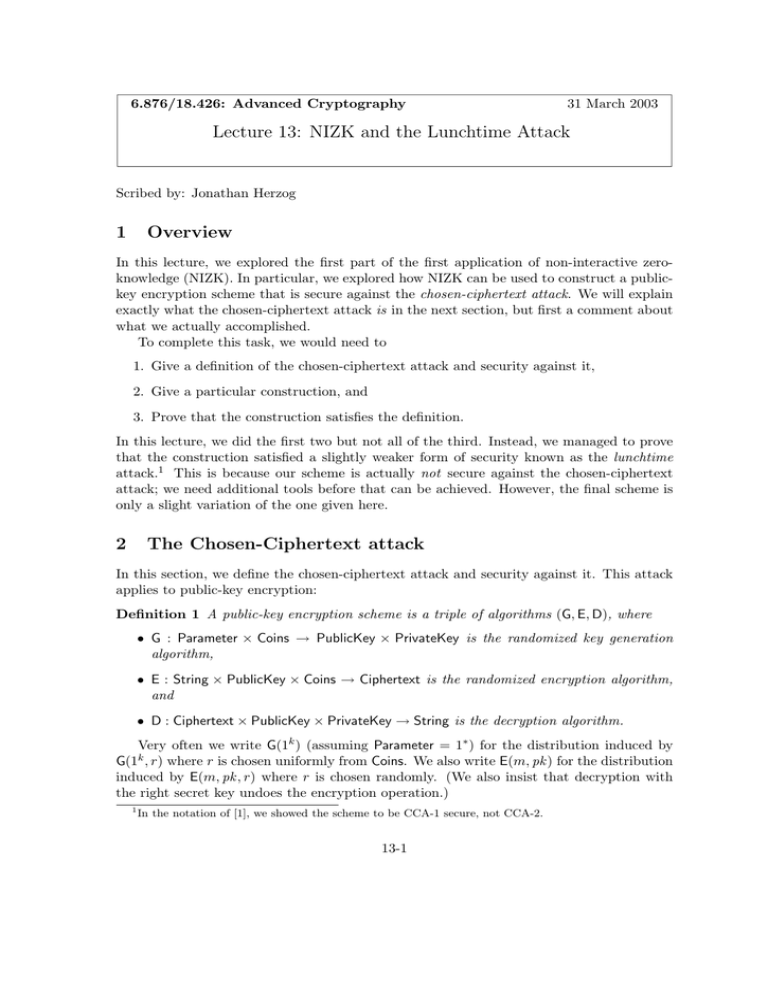
6.876/18.426: Advanced Cryptography
31 March 2003
Lecture 13: NIZK and the Lunchtime Attack
Scribed by: Jonathan Herzog
1
Overview
In this lecture, we explored the first part of the first application of non-interactive zeroknowledge (NIZK). In particular, we explored how NIZK can be used to construct a publickey encryption scheme that is secure against the chosen-ciphertext attack. We will explain
exactly what the chosen-ciphertext attack is in the next section, but first a comment about
what we actually accomplished.
To complete this task, we would need to
1. Give a definition of the chosen-ciphertext attack and security against it,
2. Give a particular construction, and
3. Prove that the construction satisfies the definition.
In this lecture, we did the first two but not all of the third. Instead, we managed to prove
that the construction satisfied a slightly weaker form of security known as the lunchtime
attack.1 This is because our scheme is actually not secure against the chosen-ciphertext
attack; we need additional tools before that can be achieved. However, the final scheme is
only a slight variation of the one given here.
2
The Chosen-Ciphertext attack
In this section, we define the chosen-ciphertext attack and security against it. This attack
applies to public-key encryption:
Definition 1 A public-key encryption scheme is a triple of algorithms (G, E, D), where
• G : Parameter × Coins → PublicKey × PrivateKey is the randomized key generation
algorithm,
• E : String × PublicKey × Coins → Ciphertext is the randomized encryption algorithm,
and
• D : Ciphertext × PublicKey × PrivateKey → String is the decryption algorithm.
Very often we write G(1k ) (assuming Parameter = 1∗ ) for the distribution induced by
G(1k , r) where r is chosen uniformly from Coins. We also write E(m, pk ) for the distribution
induced by E(m, pk , r) where r is chosen randomly. (We also insist that decryption with
the right secret key undoes the encryption operation.)
1
In the notation of [1], we showed the scheme to be CCA-1 secure, not CCA-2.
13-1
2.1
Static Adversaries
What does it mean for an encryption scheme to be secure? Against a static adversary, the
gold standard for security is that of semantic or general message (GM) security. Infor­
mally, this definition states that no efficient (PPT) adversary has a non-negligible chance
of telling whether an encryption contains message m0 or message m1 as plaintext, even if
the adversary chooses m0 and m1 itself. More formally,
Definition 2 A public-key encryption algorithm (G, E, D) is semantically secure if:
∀AdvPPT 2 = (Adv1 , Adv2 ), ∀ polynomials q, ∀ sufficiently large k,
Pr[ (pk , sk ) ← G(1k );
m0 , m1 , s ← Adv1 (1k , pk );
b ← {0, 1} ;
c← Epk (mb );
g ← Adv2 (1k , pk , m0 , m1 , c, s)
1
g = b ] ≤ 21 + q(k)
Note: This is not exactly the definition given in class. The definition given in class
is the “three-pass” version of semantic security, meaning that m0 and m1 do not depend on
the choice of public key pk . In this, more convenient version, the adversary can choose the
messages after examining the public key. For further discussion, see [2].
2.2
Adaptive Adversaries
The adaptive adversary is very similar to the static adversary. It is certainly trying to play
the same game: distinguishing an encryption of m0 from an encryption of m1 . It still gets
to choose m0 and m1 based on the public key pk . However, it now has access to some help:
decryption oracles. Suppose that before the adversary chooses the messages m0 and m1 it
can query a decryption oracle (decryption with the secret key sk , that is) as many times as
it likes on whatever input it likes. Then the adversary is launching a lunchtime attack :
Definition 3 A public-key encryption algorithm (G, E, D) is secure against a lunchtime
attack if:
∀Adv = (Adv1 , Adv2 ), ∀ polynomials q, ∀ sufficiently large k,
Pr[ (pk , sk ) ← G(1k );
O(·)
m0 , m1 , s ← Adv1 (1k , pk );
b ← {0, 1} ;
c←Epk (mb ) :
Adv2 (1k , pk , m0 , m1 , c, s) = b ] ≤
1
2
+
1
q(k)
where O(·) = D(sk , ·).
If the adversary has access to the decryption oracle not only before choosing m0 and m1
but also after receiving the challenge ciphertext c, then it can launch a fully adaptive chosen
ciphertext attack. To keep the definition from being trivial, we insist that post-challenge
oracle refuse to decrypt c. It will, however, decrypt any other input:
13-2
Definition 4 A public-key encryption algorithm (G, E, D) is secure against an adaptive
chosen-ciphertext attack if:
∀Adv = (Adv1 , Adv2 ), ∀ polynomials q, ∀ sufficiently large k,
Pr[ (pk , sk ) ← G(1k );
O (·)
m0 , m1 , s ← Adv1 1 (1k , pk );
b ← {0, 1} ;
c← Epk (mb ) :
O (·)
Adv22 (1k , pk , m0 , m1 , c, s) = b ] ≤
1
2
+
1
q(k)
where O1 (·) = D(sk , ·) and O2 (·) = D(sk , ·) if the input is not equal to c and ⊥ if it is.
It is these definitions that we will use in our proof.
3
The Construction
The following construction is due to Naor and Yung [3]. The basic intuition is that the
sender should not only encrypt, but also provide a proof that he knows the plaintext. If
this can be done, then the adversary gains no information during the chosen-ciphertext
attack: it already knows the answer it would get from the decryption oracle.
Although we cannot do exactly this, we do something close:
Let (G, E, D) be a semantically secure encryption scheme. Let (P, V, S) be a NIZK proof
scheme for the language
�
�
L = e1 , e2 , pk |∃m, r1 , r2 such that e1 = E(m, pk , r1 ) ∧ e2 = E(m, pk , r2 )
This language is in N P , and for any (e1 , e2 , pk ) ∈ L, a witness is the (m, r1 , r2 ) from the
language definition.
Then, let:
• G, on input 1k , run G on input 1k twice to produce two key pairs (pk 1 , sk 1 ) and
(pk 2 , sk 2 ). It also produces a “sufficiently long” random string R, and outputs pk =
(pk 1 , pk 2 , R) and sk = (sk 1 , sk 2 ).
• E, on input (m, (pk 1 , pk 2 , R)), produces random strings r1 and r2 by flipping coins.
It then runs E(m, pk 1 , r1 ) to produce e1 , runs E(m, pk 2 , r2 ) to produce e2 , and runs P
on e1 , e2 , m r1 and r2 (using R as the reference string) to produce a proof π. It then
outputs (e1 , e2 , π).
• D, on input (e1 , e2 , π), (pk 1 , pk 2 , R) and (sk 1 , sk 2 ), first verifies the proof π using V
and the reference string R . If the proof verifies, it decrypts e1 using D and sk 1 .
Question: Why is it important that the decryption oracle verify π? For that matter,
why should we even use the proof system? Why not just decrypt e1 and e2 , and test to see
if they contain the same plaintext?
Answer: The answer is that we don’t want the decryption algorithm to reveal any in­
formation to the adversary that the adversary would not already know in creating a cipher­
text. Hence, unless the adversary proves that the ciphertexts contain the same plaintext,
13-3
the decryption oracle reveals that information to it. (And since the proof system guarantees
soundness, the adversary must know the mutual plaintext of the two encryptions to produce
a valid proof π.)
Question: What if there are multiple senders? Then we have multiple provers all using
the same reference string R without any sort of synchronization. Will this be a problem?
Answer: No, it won’t. We need a NIZK proof system that can handle multiple provers
that don’t necessarily synchronize — and they exist. (Alternately, we can provide a different
reference string to each sender, but this is inelegant and breaks the public-key model.)
4
4.1
Proof of Security
Completeness
Is this a public-key encryption scheme? That is, if an honest sender encrypts m to produce
e, will the honest receiver decrypt e to produce m? With overwhelming probability, the
honestly-generated proof π will verify (due to the completeness of the proof system.) And
with overwhelming probability, decrypting an honestly made e1 with sk 1 will produce the
original message m. So yes, this is a public-key encryption scheme.
Question:(From Professor) Can we get perfect completeness? That is, can we get a
scheme were the honest verifier will get the plaintext with probability 1?
Answer: (From Chris) Yes, since NIZK is an AM(2), and we can always get a proof
system for AM(2) with perfect completeness. (How? Take a proof system that has com­
pleteness with probability almost 1. If you find yourself in the unlikely situation where you
would not get completeness with the intended system, simply send the witness or message
instead.)
4.2
Soundness
Will the adversary ever be able to get a “decryption” of a malformed ciphertext (e1 , e2 , π)?
No, because the underlying proof system is sound.
4.3
Security against the Lunchtime Attack
(The Professor titled this section ZK because the proof ultimately derives from the fact that the
proof system is ZK. But security against the lunchtime attack it what is ultimately proven.)
Suppose that there exists an adversary Adv = (Adv1 , Adv2 ) which can successfully com­
plete a lunchtime attack against this scheme. That is, suppose
∃Adv = (Adv1 , Adv2 ), ∃ a polynomial q, for infinitely many k,
Pr[ (pk , sk ) ← G(1k );
O(·)
m0 , m1 , s ← Adv1 (1k , pk );
b ← {0, 1} ;
c ← Epk (mb ) :
Adv2 (1k , pk , m0 , m1 , c, s) = b ] ≥
13-4
1
2
+
1
q(k)
where O(·) = D(sk , ·). Then we can use Adv to construct adv, an adversary that violates
the semantic security of (G, E, D). Here is how we construct adv:
• adv1 , on input 1k and pk (where pk is a public key of (G, E, D)):
1. Flips a coin to select p ← {1, 2}. Without loss of generality, let p = 1, meaning
that the ciphertext adv will try to break will be in the second position. (This
will be clearer in a second.)
2. Runs G(1k ) to produce pk 1 and sk 1 .
3. Uses the simulator S of the NIZK proof scheme to generate a reference string R.
4. Gives (pk 1 , pk , R) to Adv1 .
5. When Adv1 makes a request to the decryption oracle on ciphertext (e�1 , e�2 , π � ), it
verifies the proof and (if it passes) returns the output of D(e�1 , sk 1 ).
6. When Adv1 produces the messages m0 and m1 (with state information s, adv1
outputs m0 , m1 , and s� = (pk1 , R, s, s�� ), where s�� is whatever state information
the simulator S needs to maintain.
• adv2 , on input 1k , pk , m0 , m1 , c, s� = (r, pk 1 , R, s, s�� ):
1. Creates the “ciphertext” for Adv2 from c by picking r ← {0, 1}, encrypting
mr under public key pk 1 to create c� , and running the simulator (with state
information s�� ) to create a “proof” π.
2. Runs Adv2 on input 1k , (pk 1 , pk , R), m0 , m1 , (c� , c, π) and s.
3. When Adv2 returns a guess g, adv2 returns g.
The ciphertext c given to adv2 will be the encryption of mb where b ∈ {0, 1}. With what
probability will the g returned by adv2 equals b? Here we only sketch the proof, but present
the essential idea.
There are two cases:
1. If r = b, then adv2 chose to encrypt the same message as was given to it in c. Hence,
the input given to Adv2 is two encryptions of mb and a “proof” of that fact. If the
proof is indistinguishable from a real proof (which it must be, at least computationally,
due to the definition of the simulator S) then this is exactly the input expected by
1
Adv2 . Hence, Adv2 (and thus adv2 ) will return b with probability at least 21 + q(k)
.
2. In the other case, adv2 decides to encrypt the other message. Hence, Adv2 receives
as input one encryption of m0 and one encryption of m1 . Recall that p, the position
of the input ciphertext, was chosen randomly. Hence, the input contains exactly no
information about which encryption was the input to adv2 and which was created by
it. Hence, Adv2 has exactly a 50% chance of being able to return as g the message
which was adv2 ’s input.
The two cases are equally likely. Thus, the chances that adv2 returns the correct value as g
is
11 1 1
1
1
+
= +
2 2 2 q(k)
2 2q(k)
13-5
which is still non-negligible.
Question: As adv simulates Adv, it must choose the reference string R before it knows
the theorem to be “proven”. (That is, before it knows which encryptions must be proven
to have the same plaintext.) Can this be done?
Answer: Yes, and this is why I (Professor) made such a big deal about it when I demon­
strated it.
Question: (From Professor) Does this proof still work if we move to a fully adaptive chosenciphertext attack? That is, does it still work if Adv2 has access to a decryption oracle as
well?
Answer: Go home and think about it. [Scribe note: the answer is “no,” but I’m not
telling you why.]
5
Choice Quotes from The professor
• “When it’s convenient to me, I lie whenever I can.”
• “I was wise enough to not write down what I wanted to prove; that helps me.”
References
[1] M. Bellare, A. Desai, D. Pointcheval, and P. Rogaway. Relations among no­
tions of security for public-key encryption schemes.
In H. Krawczyk, edi­
tor, Advances in Cryptology (CRYPTO 98), volume 1462 of Lecture Notes in
Computer Science, pages 26–45. Springer–Verlag, 1998.
Full version found at
http://www.cs.ucsd.edu/users/mihir/papers/relations.html.
[2] Silvio Micali, Charles Rackoff, and Bob Sloan. The notion of security for probabilistic
cryptosystems. SIAM Journal on Computing, 17(2):412–426, April 1988.
[3] M. Naor and M. Yung. Public-key cryptosystems provably secure against chosen ci­
phertext attacks. In 22nd Annual ACM Symposium on Theory of Computing, pages
427–437, 1990.
13-6
